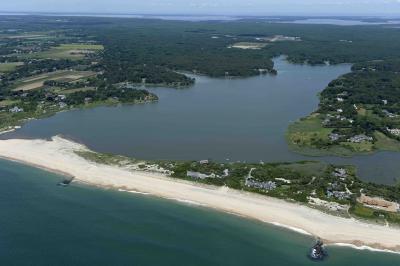More Than One Culprit Fouling Pond

The dense blooms of cyanobacteria, or blue-green algae, that resulted in the closure of Georgica Pond in East Hampton to crabbing and warnings against exposure for the third consecutive summer have overshadowed another threat to the well-being of the South Fork’s waterways and the people who use them: enterococcus, a coliform bacteria that indicates the presence of fecal matter in the water.
On July 21, Colleen Henn, who conducts weekly water-quality sampling on the South Fork for the Surfrider Foundation’s Blue Water Task Force, sent an email to Lars Svanberg, who owns Main Beach Surf and Sport, a Wainscott provider of sporting goods including kayaks, stand-up paddleboards, and canoes. A sample Ms. Henn took on July 5 at the Georgica Pond kayak launch on Montauk Highway, which is used by Main Beach Surf and Sport, measured almost 70 times above the federal Environmental Protection Agency’s standard for recreational exposure, she told Mr. Svanberg. While subsequent samples from the site have shown decreased bacteria, levels remained more than twice the E.P.A.’s recommended limit, she wrote.
“I don’t have the authority to tell you what you should or shouldn’t do,” Ms. Henn wrote, “but I feel morally obligated to tell you what I do know about the kayak launch. Given the current harmful algal bloom and a confirmed presence of coliform bacteria, I doubt those waters are safe for recreational use.”
The July 5 sample, however, was not particularly surprising, as it closely followed a heavy rainfall on July 1 and the concurrent arrival of thousands of visitors to the South Fork for the Fourth of July weekend. On July 5 came the largest rainfall event of 2016, when 1.4 inches fell, said Christopher Gobler of Stony Brook University’s School of Marine and Atmospheric Sciences, who monitors waterways under the East Hampton Town Trustees’ jurisdiction.
“Suffolk County preemptively shuts down beaches anytime it rains more than one inch in summer,” Dr. Gobler wrote in an email, “as they know that leads to high levels of bacterial contamination from runoff.” He cautioned against undue alarm over the July 5 sample from the kayak launch. High levels are to be expected, he said, “due to it being a low point, along the road, and thus being designed to drain all water to that point.”
Sara Davison, executive director of the Friends of Georgica Pond Foundation, a group of pondfront homeowners that has also engaged Dr. Gobler in a cyanobacteria remediation effort, said that “fecal coliform contamination is also a consideration of all of our ponds, especially after big rain events,” but is typically short-lived. “I’m not saying it’s not a concern, it’s very much a concern.” It would be useful to determine the species responsible for the coliform bacteria entering the pond, whether human or wildlife, she said, adding that DNA testing can make that determination.
“We’re going to check on the Surfrider data and have Dr. Gobler occasionally test as well to verify that,” Ms. Davison said. Structural changes on Montauk Highway to intercept runoff before it enters the pond would also help, she suggested.
In a resort community such as East Hampton, compromised waterways have obvious far-reaching implications, for residents and visitors alike. “We’ve lost recreational and fishing opportunities on every water body south of the highway, which is really a shame,” said Rick Drew, a town trustee. Before the trustees’ temporary closures of Georgica Pond to crabbing, he said, “It was truly a wonderful bounty. The kids would have a great time, you’d go home and have a nice dinner, and you felt a deep connection to the community. Now, you risk the health of yourself and your family to do traditional recreational pursuits that people have enjoyed here for hundreds of years, and some people made a living out of it.”
“We’ve backed off putting people in the pond,” Mr. Svanberg said on Tuesday, “and focused on the north side of East Hampton: Northwest Creek, Cedar Point. Luckily, we have a few options.”
As Ms. Henn wrote, the Surfrider Foundation does not have authority to close beaches or waterways. Nonetheless, “it’s good citizen science and jump-starts some action,” said Kim Shaw, director of the town’s Natural Resources Department, who said yesterday that she has previously referred the group’s data to the Suffolk County Department of Health Services, which issues beach advisories and closures. Following rains last week, the department advised against bathing at 62 beaches it deemed susceptible to stormwater runoff and the consequent potential for bacteria levels exceeding state standards. An additional advisory for seven beaches was issued on Tuesday. The advisories are typically in effect through two tidal cycles, or at least 24 hours, after rainfall has ceased.
“I would like to do more monitoring” for bacteria in waterways, Ms. Shaw said. “For the budget next year, we’re looking into purchasing some stand-alone water-quality monitoring stations. The town board has been generous in putting aside money for water-quality monitoring.”
Georgica Pond remains closed to fishing and shellfish harvesting. The town trustees typically open Georgica Pond to the Atlantic Ocean in the spring and fall, restoring salinity and dissolving any harmful algal blooms. They have also applied to the State Department of Environmental Conservation for a dredging permit, which they believe will further improve the pond’s health.
Mr. Svanberg, however, wonders if that will be enough. “Because of all the nitrates, the effluent going in, we’re reaching a point of no return where they can’t control it by letting it out,” he said. “People have to take the next steps: upgrade sewer systems, stop using fertilizer.” It is time, he said, “for everybody to pitch in and be their own activist. We’ve got some beautiful resources out here, and we have to take care of them.”
